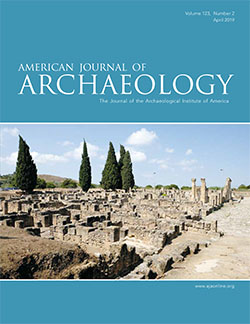AJA Open Access
BY-NCApril 2019 (123.2)
Book Review
Landscape Dynamics and Settlement Patterns in Northern Anatolia During the Roman and Byzantine Period
Edited by Kristina Winther-Jacobsen and Lâtife Summerer
Reviewed by Emanuele E. Intagliata
The volume presents a collection of contributions dedicated to the archaeology of northern Anatolia in the Roman and Byzantine periods. By involving scholars from both museum and academic institutions, it explores the state of research in the region, offering an important glimpse of the results of several international projects in Paphlagonia and Pontus. The book stems from a conference held in Amasya in 2014 that was part of the research project Where East Meets West (University of Southern Denmark) sponsored by the Danish Council for Independent Research.
The book contains four distinct sections. Section 1, on “the dynamics of landscapes,” deals with the interaction between cities and their territories and includes seven closely linked contributions. Bes illustrates the finds of the Cide Archaeological Project, exploring changes in settlement patterns between the Roman and Byzantine periods and putting forward tentative locations for several places named in the Tabula Peutingeriana based on newly acquired archaeological evidence. Doonan discusses the transformation of settlement patterns based on the results of the Sinop Regional Archaeological Project, concluding that, even at the regional level, there is much variability in terms of the nature and fate of settlements between the Late Roman and Early Byzantine periods. The cultural transformation of Pompeiopolis and its territory between the Hellenistic and the Roman periods, with specific focus on the “landscapes of the dead,” is explored by Johnson. Winther-Jacobsen illustrates the finds of the Where East Meets West project in the hinterland of Neoklaudiopolis, focusing on the Papaz Tarlası martyrium complex and the remains at Tepeören. The chapter by Bikoulis, Elton, Haldon, and Newhard takes a more methodological angle than the preceding contributions by exploring how different survey techniques (intensive field survey, remote sensing survey, and “super-intensive” survey) can be helpful to gain a diverse array of data; its case study is a Byzantine church at Avkat. Ritter provides the reader with the status quaestionis of the transformation of cities in Late Antique northern Anatolia. A report written by Özdemir on rescue excavations conducted at the Sanctuary of Zeus Stratios (Yassıçal) in the province of Amasya concludes this section.
Section 2, on “the dynamics of mortuary space,” discusses case studies of Roman funerary space. Hnila effectively demonstrates how the study of a necropolis can provide important data on the nature and fate of a settlement, taking as an example Oymaağaç Höyük, a Roman-Byzantine burial mound; the ensuing contribution by Sauer discusses two coins from the same excavation. Koch’s chapter explores tombstones from the territory of Pompeiopolis to pinpoint changes in the cultural character of this community. Finally, two reports, by Doğanbaş and Ivgin, present the result of rescue excavations of burials from Amasya and Zafer (Samsun province).
Art historical contributions are collected in section 3, on “the dynamics of decoration.” The first paper, by Aydın, Buccino, and Summerer, deals with two often overlooked Roman statues from Amastris reburied in the late fourth or early fifth century C.E. The chapter by Musso provides an exhaustive analysis of a collection of mosaics from several Roman and Late Antique sites in northern Anatolia, stressing effectively the artistic connection of northern Anatolia with Near Eastern decorative traditions. Keskin reports on the excavation of an unidentified building with mosaic floors at Yavru, a village in the province of Amasya.
Finally, section 4, on “the dynamics of circulation,” includes papers by Bekker-Nielsen and Czichon on Roman roads in the area of Neoklaudiopolis; by Marek on the Paphlagonian koinon and recent epigraphic discoveries; and by Sauer on minting practices in the Pontic area, with a specific section dedicated to Neoklaudiopolis and Pompeiopolis. The book concludes with useful indices.
The editors of this book deserve praise for successfully collecting in a single, coherent contribution an excellent selection of papers touching on a wide array of issues in archaeology, history, and art history. The volume reflects the growing interest of the international academic community in northern Anatolia and demonstrates the potential of this region for the understanding of broader, empire-wide issues. Scholars interested in Roman and Byzantine Anatolia will find in this volume an invaluable resource. The book is mostly intended for specialists. Undergraduate students with little fieldwork experience may find the reading irksome. Advanced students interested in reaching a deeper understanding of landscape archaeology methodologies or current scholarly debates, such as the fate of cities and their hinterlands between the Roman and Middle Byzantine periods, would certainly benefit from the reading of these chapters.
Emanuele E. Intagliata
Centre for Urban Network Evolutions (UrbNet)
Aarhus University
e.e.intagliata@cas.au.dk
